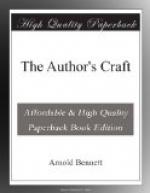I begin to think that great writers of fiction are by the mysterious nature of their art ordained to be “amateurs.” There may be something of the amateur in all great artists. I do not know why it should be so, unless because, in the exuberance of their sense of power, they are impatient of the exactitudes of systematic study and the mere bother of repeated attempts to arrive at a minor perfection. Assuredly no great artist was ever a profound scholar. The great artist has other ends to achieve. And every artist, major and minor, is aware in his conscience that art is full of artifice, and that the desire to proceed rapidly with the affair of creation, and an excusable dislike of re-creating anything twice, thrice, or ten times over—unnatural task!—are responsible for much of that artifice. We can all point in excuse to Shakspere, who was a very rough-and-ready person, and whose methods would shock Flaubert. Indeed, the amateurishness of Shakspere has been mightily exposed of late years. But nobody seems to care. If Flaubert had been a greater artist he might have been more of an amateur.
IV
Of this poor neglected matter of technique the more important branch is design—or construction. It is the branch of the art—of all arts—which comes next after “inspiration”—a capacious word meant to include everything that the artist must be born with and cannot acquire. The less important branch of technique—far less important—may be described as an ornamentation.
There are very few rules of design in the novel; but the few are capital. Nevertheless, great novelists have often flouted or ignored them—to the detriment of their work. In my opinion the first rule is that the interest must be centralised; it must not be diffused equally over various parts of the canvas. To compare one art with another may be perilous, but really the convenience of describing a novel as a canvas is extreme. In a well-designed picture the eye is drawn chiefly to one particular spot. If the eye is drawn with equal force to several different spots, then we reproach the painter for having “scattered” the interest of the picture. Similarly with the novel. A novel must have one, two, or three figures that easily overtop the rest. These figures must be in the foreground, and the rest in the middle-distance or in the back-ground.
Moreover, these figures—whether they are saints or sinners—must somehow be presented more sympathetically than the others. If this cannot be done, then the inspiration is at fault. The single motive that should govern the choice of a principal figure is the motive of love for that figure. What else could the motive be? The race of heroes is essential to art. But what makes a hero is less the deeds of the figure chosen than the understanding sympathy of the artist with the figure. To say that the hero has disappeared from modern fiction is absurd. All that has happened




